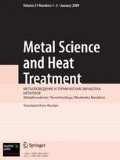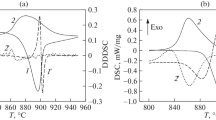We propose an atomistic description of polymorphic transformations in metal alloys, according to which an elementary act of transformation is reduced to the transfer of diagonals of a rhombus formed by two triangles. Metallic atoms are located in the corners of these triangles, and their common edge is transferred (i.e., turns into the long diagonal of rhombus). We estimated the energy barrier of polymorphic transformation (transfer of the diagonals) for various types of filling of the corners with iron, chromium, and manganese atoms in different combinations. The energy threshold is computed by using the Morse pair potential. The numerical parameters of the function approximating the potential are calibrated by the experimental values of the energy of sublimation and the temperature dependences of the elastic constants of iron, chromium, and manganese.






Similar content being viewed by others
References
E. C. Bain, “The nature of martensite,” Trans. AIME,70, 25 – 46 (1924).
G. Kurdjumov and G. Sachs, “Uber den Mechanismus der Stahl-hartung,” Z. Physik,64(5–6), 325 – 343 (1930).
C. M. Wayman, Introduction to the Crystallography of Martensite Transformation, Macmillan, New York (1964).
G. V. Kurdyumov, L. M. Utevskii, and R. I. Éntin, Transformations in Iron and Steel [in Russian], Nauka, Moscow (1977).
E. Pereloma and D. Edmonds, Phase Transformations in Steels, Vol. 2, Woodheard Publ., Oxford (2012).
B. N. Delone, N. P. Dolbilin, M. I. Shtogrin, and R. V. Galiulin, “Local criterion of correctness of a system of points,” Dokl. Akad. Nauk SSSR, 227, 19 – 21 (1976).
V. S. Kraposhin, A. L. Talis, and J.-M. Dubois, “Structural realization of the polytope approach for the geometrical description of the transition of a quasicrystal into a crystalline phase,” Phys. Condensed Matter, 14(9), 8987 – 8996 (2002).
B. K. Vainshtein, “Methods of structural crystallography,” in: Modern Crystallography, Vol. 1: Symmetry of Crystals [in Russian], Nauka, Moscow (1979), pp. 163 – 164.
V. S. Kraposhin, M. N. Pankova, A. L. Talis, and Yu. A. Freiman, “An application of a polytope (4D-polyhedron) concept for the description of polymorphic transitions: iron martensite and solid oxygen,” J. Phys. IV. (Proceedings), France, 112, 119 – 122 (2003).
A. I. Bobenko, U. Pinkall, and B. A. Springborn, “Discrete conformal maps and ideal hyperbolic polyhedra,” Geom. Topol., 19, 2155 – 2215 (2015).
B. L. Dubrovin, S. P. Novikov, and A. T. Fomenko, Modern Geometry [in Russian], Editorial, Moscow (2001).
E. Lord, Symmetry and Pattern in Projective Geometry, Springer, London (2012).
V. S. Kraposhin, A. L. Talis, and Y. J. Wang, “Description of polymorphic transformations of Ti and Zr in the framework of the algebraic geometry,” Mater. Sci. Eng., Ser. A, 438 – 440, 85 – 89 (2006).
A. Talis and V. Kraposhin, “Finite noncrystallographic groups, 11-vertex equi-edged triangulated clusters and polymorphic transformations in metals,” Foundat. Crystallogr., 70(6), 616 – 625 (2014).
S. Yu. Kondrat’ev, V. S. Kraposhin, G. P. Anastasiadi, and A. L. Talis, “Experimental observation and crystallographic description of Mg7C3 carbide transformation in Fe – Cr – Ni – C HP-type alloy,” Acta Mater., 100, 275 – 281 (2015).
V. Kraposhin, I. Jakovleva, L. Karkina, et al., “Microtwinning as a common mechanism for the martensitic and pearlitic transformations,” J. Alloys Comp., 577(1), S30 – S36 (2013).
J. E. Jones, “On the determination of molecular fields. II. From the equation of state of a gas,” Proc. Royal Soc. Lond. A: Math. Phys. Eng. Sci., 106(738), 463 – 477 (1924).
S. Zhen and G. J. Davies, “Calculation of the Lennard–Jones n – m potential energy parameters for metals,” Phys. Status Solidi (A), 78(2), 595 – 605 (1983).,
H. Heinz, R. A. Vaia, B. L. Farmer, and R. R. Naik, “Accurate simulation of surfaces and interfaces of face-centered cubic metals using 12 – 6 and 9 – 6 Lennard–Jones potentials,” J. Phys. Chem., Ser. C, 112(44), 17281 – 17290 (2008).
D. G. Pettifor, Bonding and Structure of Molecules and Solids, Clarendon, Oxford (1996).
P. M. Morse, “Diatomic molecules according to the wave mechanics. II. Vibrational levels,” Phys. Rev., 34(1), 57 (1929).
P. Zhang, Y. Huang, P. H. Geubelle, et al., “The elastic modulus of single-wall carbon nanotubes: a continuum analysis incorporating interatomic potentials,” Int. J. Solids Struct., 39(13), 3893 – 3906 (2002).
R. C. Lincoln, K. M. Koliwad, and P. B. Ghate, “Morse-potential evaluation of second- and third-order elastic constants of some cubic metals,” Phys. Rev., 157(3), 463 (1967).
D. G. Pettifor, “Electron theory of metals,” in: Physical Metallurgy, Vol. 1, North-Holland, Amsterdam (1996), pp. 47 – 133.
P. D. Desai, “Thermodynamic properties of iron and silicon,” J. Phys. Chem. Ref. Data, 15(3), 967 – 983 (1986).
D. S. Dickson, J. R. Myers, and R. K. Saxer, “The vapor pressure and heat of sublimation of chromium,” J. Phys. Chem., 69(11), 4044 – 4046 (1965).
T. C. Ehlert, “A mass spectrometric study of the sublimation of manganese,” J. Inorg. Nucl. Chem., 31(9), 2705 – 2710 (1969).
Z. Yang, Q. Wang, X. Shan, et al., “DFT study of Fe – Ni core-shell nanoparticles: Stability, catalytic activity, and interaction with carbon atom for single-walled carbon nanotube growth,” J. Chem. Phys., 142(7), 074306-1 – 074306-8 (2015).
R. Singh and P. Kroll, “Structural, electronic, and magnetic properties of 13-, 55-, and 147-atom clusters of Fe, Co, and Ni: A spin-polarized density functional study,” Phys. Rev., Ser. B, 78(24), 245404-1 – 245404-12 (2008).
C. Zener, “Theory of D0 for atomic diffusion in metals,” J. Appl. Phys., 22(4), 372 – 375 (1951).
J. W. Christian, The Theory of Transformations in Metals and Alloys, Pergamon, Amsterdam (2002).
H. M. Ledbetter and R. P. Reed, “Elastic properties of metals and alloys. I. Iron, nickel, and iron-nickel alloys,” J. Phys. Chem. Ref. Data, 2(3), 531 – 618 (1973).
K. W. Katahara, M. Nimalendran, M. H. Manghnani, and E. S. Fisher, “Elastic moduli of paramagnetic chromium and Ti – V – Cr alloys,” J. Phys., Ser. F: Metal Phys., 9, 2167 – 2176 (1979).
J. T. Lenkkeri and E. E. Lahteenkorva, “An investigation of elastic moduli of vanadium-chromium alloys,” J. Phys., Ser. F: Metal Phys., 8(8), 1643 – 1651 (1978).
W. Köster, “Die Tenperaturabhängïgkeit des Elasticitätsmoduls reiner Metale,” Z. Metallkunde, 39, 1 – 12 (1948).
M. Rosen, “Elastic moduli and ultrasonic attenuation of polycrystalline α-Mn from 4.2 to 300 K,” Phys. Rev., 165, 357 – 359 (1968).
N. D. Tripathi, K. Shanker, and R. P. Khare, “The Anderson– Grüneisen parameter for 16 crystals of cubic symmetry,” J. Appl. Phys., 49, 4282 – 4283 (1978).
W. A. Harrison, Elementary Electronic Structure, World Scientific, Singapore (1999).
M. Hilbert, “Diffusion and interface control of reactions in alloys,” Metal. Trans., Ser. A, 6(1), 5 – 19 (1975).
G. P. Krielaart and S. Van der Zwaag, “Kinetics of γ → α phase transformation in Fe – Mn alloys containing low manganese,” Mater. Sci. Technol., 14, 10 – 18 (1998).
D. A. Mirzaev, K. Yu. Okishev, V. M. Schastlivtsev, et al., “Transformation of austenite into ferrite in the ‘classical’ Fe – 9% Mn alloy. Analysis of the literature data. Investigations of the authors,” Izv. Chelyabinsk. Nauch. Tsentr, No. 2, 27 – 32, 33 – 38 (1998).
V. S. Kraposhin, A. L. Talis, and M. I. Samoilovich, “Axial (helical) substructures determined by the root lattice E8 as generating clusters of the condensed phases,” J. Noncrystal. Solids, 353, 3279 – 3284 (2007).
Author information
Authors and Affiliations
Additional information
Translated from Metallovedenie i Termicheskaya Obrabotka Metallov, No. 2, pp. 8 – 17, February, 2020.
Rights and permissions
About this article
Cite this article
Semenov, M.Y., Kraposhin, V.S., Talis, A.L. et al. Transfer of Diagonals in a Rhombus: Elementary Act of Polymorphic Transformation. Analysis of the Energy Threshold of Transformation in Metals. Met Sci Heat Treat 62, 109–118 (2020). https://doi.org/10.1007/s11041-020-00522-3
Published:
Issue Date:
DOI: https://doi.org/10.1007/s11041-020-00522-3




